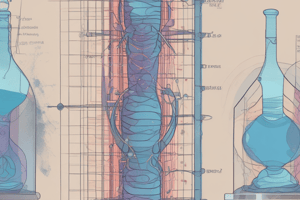Podcast
Questions and Answers
What is the primary role of the stacking gel in SDS-PAGE?
What is the primary role of the stacking gel in SDS-PAGE?
- To separate proteins based on their size.
- To compress proteins into a narrow band for more efficient separation. (correct)
- To neutralize the charge of proteins before separation.
- To increase the overall conductivity of the gel.
Which component of the gel primarily influences the mobility of proteins during electrophoresis?
Which component of the gel primarily influences the mobility of proteins during electrophoresis?
- The presence of salt in the buffer.
- The charge of the proteins.
- The pH of the resolving gel. (correct)
- The thickness of the gel.
What is the effect of SDS on proteins during electrophoresis?
What is the effect of SDS on proteins during electrophoresis?
- It eliminates the primary structures of the proteins.
- It provides a constant charge to mass ratio across different proteins. (correct)
- It enhances the native conformation of proteins.
- It increases the overall mass of the proteins.
In a discontinuous gel system, what role does the buffer in the lower chamber play?
In a discontinuous gel system, what role does the buffer in the lower chamber play?
Which of the following statements about the resolving gel is accurate?
Which of the following statements about the resolving gel is accurate?
How does the mobility of proteins change when the ionic front reaches the resolving gel?
How does the mobility of proteins change when the ionic front reaches the resolving gel?
What is the significance of the different buffers in a discontinuous gel system?
What is the significance of the different buffers in a discontinuous gel system?
Which ions are used in the stacking gel to help compress the proteins?
Which ions are used in the stacking gel to help compress the proteins?
What is the primary function of sodium dodecyl sulphate (SDS) in SDS-PAGE?
What is the primary function of sodium dodecyl sulphate (SDS) in SDS-PAGE?
How do the charges of proteins affect their movement in an electric field during electrophoresis?
How do the charges of proteins affect their movement in an electric field during electrophoresis?
What is the purpose of using reducing agents like DTT in SDS-PAGE?
What is the purpose of using reducing agents like DTT in SDS-PAGE?
What distinguishes discontinuous gels from continuous gels in electrophoresis?
What distinguishes discontinuous gels from continuous gels in electrophoresis?
What role does the stacking gel play in SDS-PAGE?
What role does the stacking gel play in SDS-PAGE?
Why is separation of DNA fragments considered simpler than separation of proteins?
Why is separation of DNA fragments considered simpler than separation of proteins?
What is the result of using SDS on multi-subunit proteins during SDS-PAGE?
What is the result of using SDS on multi-subunit proteins during SDS-PAGE?
What is a primary challenge in separating a mixture of solubilised proteins?
What is a primary challenge in separating a mixture of solubilised proteins?
What is the purpose of DTT in protein sample preparation prior to SDS-PAGE?
What is the purpose of DTT in protein sample preparation prior to SDS-PAGE?
Why is the polymerization of polyacrylamide crucial for SDS-PAGE?
Why is the polymerization of polyacrylamide crucial for SDS-PAGE?
What role does methylene bisacrylamide play in gel preparation?
What role does methylene bisacrylamide play in gel preparation?
How does SDS contribute to the electrophoresis process?
How does SDS contribute to the electrophoresis process?
What is the main function of the stacking gel in SDS-PAGE?
What is the main function of the stacking gel in SDS-PAGE?
What factor can be altered to change the pore size of the separating gel?
What factor can be altered to change the pore size of the separating gel?
What is the primary benefit of using TEMED in gel preparation?
What is the primary benefit of using TEMED in gel preparation?
In the context of electrophoresis, what does the sieving effect refer to?
In the context of electrophoresis, what does the sieving effect refer to?
Flashcards are hidden until you start studying
Study Notes
Electrophoresis in SDS-PAGE
- SDS (sodium dodecyl sulfate) imparts a uniform negative charge to proteins, enabling their flow towards the anode during electrophoresis.
- Two buffer chambers exist in a protein gel system: an upper chamber for stacking gel and a lower chamber for resolving gel.
- Different buffers create distinct electrochemical environments, facilitating protein movement into and through the gel.
- The stacking gel focuses proteins, while the resolving gel separates them based on size due to smaller pore size.
Buffer Dynamics
- Chloride ions (green) and glycinate ions (orange) compress proteins before entering the resolving gel.
- At a pH of 8.3 in the resolving gel, increased ion mobility enhances protein mobility, with smaller proteins moving faster than larger ones.
- Stacking gel pH is typically set at 6.7, while the resolving gel maintains pH 8.3, optimizing protein separation.
SDS-PAGE Overview
- SDS-PAGE is crucial for separating heterogeneous protein mixtures based on size and charge.
- Proteins' negative charges vary; hence, a uniform charge needs to be imparted for effective separation.
- SDS denatures proteins, providing a net negative charge proportional to their size, allowing for size-based migration during electrophoresis.
Sample Preparation
- The application of powerful reducing agents (e.g., DTT or mercaptoethanol) is essential for breaking disulfide bonds in proteins.
- Heating samples near 100°C ensures complete denaturation of proteins when combined with SDS and reducing agents.
Gel Composition
- Polyacrylamide gels are hydrophilic and tough, requiring cross-linking of polymer chains for effective sieving during electrophoresis.
- Methylene bisacrylamide serves as the crosslinker in gel formation, creating pores for protein separation.
- Variations in the amount of the crosslinker influence pore size, thus determining the range of protein sizes that can be effectively separated.
Studying That Suits You
Use AI to generate personalized quizzes and flashcards to suit your learning preferences.




